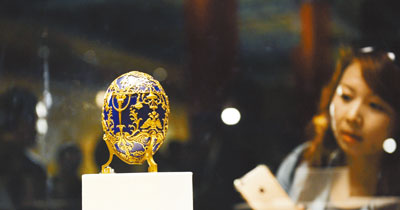
AS the Palace Museum in Beijing stages the ongoing Faberge Revealed exhibition — courtesy of the Virginia Museum of Fine Arts in the United States — displaying treasures owned by former Russian royal families, more U.S. museums want to share their collections with their Chinese counterparts. Last week, at the seventh China-U.S. High Level Consultation on People-to-People Exchanges, professionals from top-tier U.S. museums — the Peabody Essex Museum in Salem, Massachusetts, and the Freer Gallery of Art and the Arthur M. Sackler Gallery under the Smithsonian Institution, in Washington D.C., reached an agreement with the Palace Museum in Beijing for closer collaboration. Wang Yiyou, the curator of Chinese and East Asian art at the Peabody Essex Museum, says the museums will build partnerships in areas like professional exchanges, preservation, studies of objects and research. “It will be a well-rounded relationship,” she says. The Peabody Essex Museum has displayed Chinese treasures since 1800, a year after its founding, while the Freer and Sackler galleries are among the biggest repositories in the United States of Chinese cultural relics. All three institutions have worked with Chinese museums before. For example, over 2010-11, the Peabody Essex Museum worked with the Palace Museum to organize an exhibition in the United States called The Emperor’s Private Paradise: Treasures from the Forbidden City. The exhibition, which comprised cultural relics from Juanqinzhai, a studio which made exquisite decorative art for Emperor Qianlong (1711-99), toured the United States, including New York City, Boston and Milwaukee. Wang says more than half a million visitors saw the display in the United States — one of the biggest exhibitions held by the Peabody Essex Museum. “We want to cooperate with the Palace Museum to start another round of exhibitions,” says Wang. Meanwhile, according to Jan Stuart, the curator of Chinese art at the Freer and Sackler galleries, there is a program that trains “future leaders of Chinese museums” since 2000, and Li Ji, the head of the archaeology department at the Palace Museum was one of the scholars who pursued the program there. Besides, there were conservators and exhibition designers from the Palace Museum and other Chinese museums at her institution. Though the latest memorandum of understanding focuses mainly on research, especially conservation, Stuart says it will also include heavyweight exhibitions. “By pulling together our resources, talent and collections, we can create something that is beautiful,” she says. “We are not yet ready to announce details, but we can say that the exhibitions will cover the Qing Dynasty (1644-1911) and the wives in the Qing court, in a way that has never been done before.” The new partnership will combine the efforts of three institutions in research and selection of objects among other things. The publication of in-depth catalogs will also help produce new scholars in the specific fields. Jay Finney, the deputy director of the Peabody Essex Museum, who is in charge of marketing and public relations, says: “One reason why we do exhibitions is to further develop scholarship in a particular area. “The substance really is the scholarly writing and publication through the manifestation of artwork.” Meanwhile, according to data from China’s State Administration of Cultural Heritage, there were 4,692 registered museums in the country at the end of 2015, a significant increase from 3,415 at the end of 2010. But, despite the efforts to boost links between the two countries, Chinese public museums in 2013 held only six art and history exhibitions in the United States, while only two exhibitions from U.S. public museums came to China that year. This is one of the reasons why the museums are seeking to deepen ties. But there are still hurdles. For example, the China Program at the American Alliance of Art, an information-sharing platform for museums from China and the United States, was put on hold earlier this year due to funding constraints even though it got bigger and bigger, says Wang. Finney adds that there is a need to make exhibits more friendly for U.S. visitors who may not be very familiar with Chinese history. He recalls that when the Peabody Essex Museum was designing the Juanqinzhai exhibition, the museum had assumed that visitors would have a sense of Emperor Qianlong’s power and wealth. “But when we spoke to visitors, we heard things like: ‘He couldn’t be the most powerful one,’ and ‘I’ve never heard of him.’ So, we have to tell people they (Chinese historical figures) are not all that different from their lives, and try to make them more relatable,” he says. Finney says that though marketing of museums is still something new in the United States, he finds that some Chinese museums have a strong capability in the field. As smartphone apps and souvenirs from the Palace Museum have gone viral on Chinese social networks in recent years, the Peabody Essex Museum plans to send a member of its digital team for a training program to Beijing soon. (China Daily) | 
